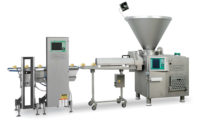Automation, sanitation, gentler handling sought for slicing, cutting, portioning equipment
Slicing, cutting, portioning equipment amps up their features and benefits.

Higher capacities, new shapes, longer blade life, automation, flexibility, sanitary design, quick changeover, and gentler handling of fragile ingredients are among the top features and benefits that snack and bakery companies want from their slicing, cutting and portioning machinery.
These types of equipment are used to make sliced, finished bread products like sandwich breads, buns, rolls, bagels, and English muffins, as well as sliced or portioned finished desserts like pies, cakes, and cheesecakes. Slicers are also vital in chip production making primary use of potatoes and other root vegetables for chips. Cutting technologies also factor into portioned granola and nutrition bar production.
Baker Perkins - TruClean Servo Bar Cutter
Customers of Baker Perkins, Peterborough, England—and with a U.S. location in Grand Rapids, MI—are asking for stainless machinery that’s easy to clean, flexible and provides for rapid changeover, says Mark Glover, product manager, baked products and extrusion. “They want to run it today and maybe not tomorrow—how do I quickly remove or add it to the line? Customers are running a lot of different types of products.”
Baker Perkins has newly redesigned its TruClean Servo Bar Cutter so that it can be reconfigured to cut a variety of products to specific piece lengths, giving the customer flexibility to run different kinds of products without needing to worry about mechanical limitations, Glover says. “It also gives them full recipe control,” he says. “It gives them all sorts of flexibility and setups for different profiles, [such as] cut lengths, how much you cut through the product.”
The engineering behind the TruClean label has ramped up the hygienic quality of the machine as well, Glover says. Baker Perkins has eliminated dead spaces for bacterial buildup and provided tool-less changeovers so operators and sanitation people have easy access for cleaning. “The flexibility, hygienic design and servo-control are all features that are new,” he says. “We can take our bar cutter, and put it across all different market segments, from extrusions to baked and confectionary products.”
Egan Food Technologies - SlabForm DUO
Egan Food Technologies, Grand Rapids, MI, hears from customers who want to form healthier products with fragile ingredients like nuts and seeds without them getting crushed, says John Micelli, who handles sales and business development. He’s also seen more sourcing from organic farms, infusions of hemp into snack products, and molded chocolates. “Natural is the big thing,” he says.
Egan last September unveiled the SlabForm DUO line, which produces granola, nutrition, and protein bars in more efficient fashion for smaller shops, Micelli says. Typically, such bars are formed in a large slab on a moving conveyor belt that might measure 1½ x 2 feet wide, which then has to be slit into, say, 10 “lanes” that then go into the guillotine to be cut to the right length. They also need to be chilled in a cooling tunnel prior to slitting so they’re very firm.
“It’s quite an elaborate process, where a typical line could be 70 feet long or more,” he says. “It’s a rather expensive capital investment. Smaller manufacturers, the artisans, the up-and-coming segment in granola, they typically either can’t afford the capital investment because their volume isn’t high enough, or don’t have the space to put large lines in.”
The DUO aims to solve that dilemma by forming a “mini-slab” that’s only as wide as the bar length, more like 4 inches, Micelli says. “And then all we need to do is guillotine it for the width, for example 1½ inches. There’s no need for slitting, which complicates things,” he says. “The machine is small, approximately 10 feet long, and it’s under $90,000, very low cost compared to the [larger] line that produces finished bars, which would be closer to $400,000.” The SlabForm DUO is geared to the artisan and specialty manufacturer, he notes.
FoodTools - TC-200 Inline Tortilla Slicer
Automation has been a major focus for customers of FoodTools, Santa Barbara, says Sergio Caballero, regional sales manager. “People are looking for full automation lines right now,” he says. “Whether it’s robotic cutting, or cutting in-line, we’ve been doing a lot in that area. … They’re still streamlining their processes and eliminating people off the line—with the workforce issue, it’s hard to get people to work.”
FoodTools has been rolling out customized versions of its TC-200 inline tortilla slicer that take stacks of corn tortillas and cut them into chips at high production speeds, Caballero says. The company also has been getting into high-speed, in-line brownie production with automated processes, again customized to meet end-users’ needs. “Every machine we’re doing is very customized to the application, whether it’s the bakery, whether it’s tortilla,” he says.
Grote Co. - Slicer/Applicator
Tanner Adams, slicing specialist with the Grote Co., Columbus, OH, says his customers are also focused on sanitary design, as well as ease of use, ease of integration, and automation. “Easier is always better. The more bells and whistles something has, translates to needing more knowledge to run the equipment,” he says. “If a company has high turnover, that piece of equipment will likely run poorly.”
Labor shortages of late have meant that customers want to incorporate more automation, Adams says. “The use of automation also can provide a solution to companies who may have faced workers having to take time off due to COVID outbreaks, for example,” he says. “A human workforce comes with challenges that automating operations can help address. Workers are freed up to manage other tasks.”
Grote has redesigned its flagship Slicer/Applicator, focusing primarily on quality-of-life improvements that are sometimes overlooked, Adams says. “How easy is it to replace parts? Can we design a machine that’s so quiet, you have to make sure it’s running? What new technology exists, and how does it make us better?”
The newly configured machine provides the ability to safely and easily reach every section of it, which aids in sanitation “and makes the machine more much enjoyable to work on,” Adams says. “Our use of solid tubing and our open channel frame allows no spot to go uncleaned and gives us a secondary benefit of having more weight. That additional weight, along with enhanced servo controls, makes for a much smoother and quieter slicing experience.”
Lematic - G8 Slicing System
LeMatic, Jackson, MI, hears a few specific requests from customers, says Richard Kirkland, president. “They want lower maintenance machines, they want blade life to be extended, and they’d like more versatility from the slicers themselves,” he says. “We feel like we’re addressing all that; we feel like we hear it.”
LeMatic has come out with the G8 Slicing System, which focuses pressure on the product that’s independent of the slicing position, Kirkland says. In in the past, operators that wanted to obtain more pressure needed to lower the slice height. “Now, those two things are independent,” he says. “It allows for a more versatile slicer. You don’t need a [separate] slicer for croissants, vs. ciabatta, vs. a standard roll.”
Although they’re mostly in R&D now, LeMatic plans a big push to produce IOT sensors that will allow machines to monitor conditions and make suggestions, providing feedback loop control, Kirkland says. The company also is developing dashboards that show vibratory analyses and show when “things aren’t quite right, so we can do predictive maintenance,” he says.
Urschel Laboratories - Model CC Slicer Affinity CD-L Dicer
Companies making higher-capacity fryers want modernized heads for faster slicing, says Mike Jacko, vice president of applications & new production innovation at Urschel Laboratories, Chesterton, IN. He’s also heard people asking for new shapes, but when shown the range already available on the company’s Model SS Slicer—and told what a special cut would cost—most customers reconsider. “They have to cost-justify it,” he says.
Urschel has upgraded its Model CC Slicer with new SL14 cutting heads that go into the existing machine that are more sanitary and provide greater use of ease and higher capacity, Jacko says. That’s been helpful during COVID because fewer people were able to work in person and turnover has been greater. “Snack guys are playing musical chairs with employees. They can’t keep them, they don’t come to work, they take another job,” he says. “These heads make it so you don’t need a technically advanced operator to run them.”
The company also upgraded the Affinity CD-L Dicer into a “much more sanitary” version that can be used for items like dried fruits or cheese that’s an additive to snacks, Jacko says. Whereas the previous model would have needed to shut down probably every 30 to 45 minutes to be cleaned due to the buildup of sticky products, the newer model can run a few hours at a time, he says.
Looking for a reprint of this article?
From high-res PDFs to custom plaques, order your copy today!





